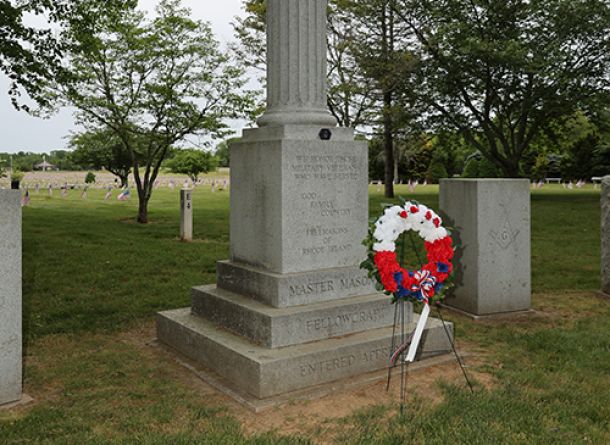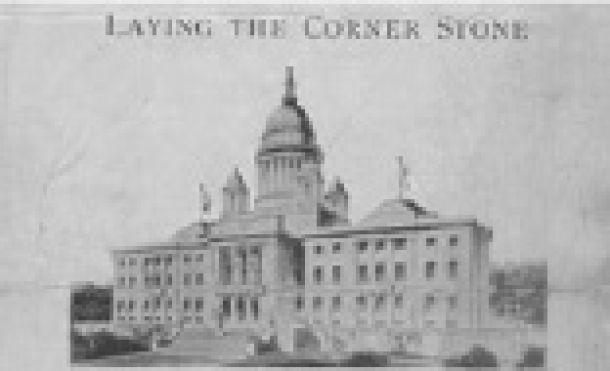The Esoteric Meaning of the Twin Pillars Boaz & Joachim
From a presentation given at a meeting of the Rhode Island and Providence Plantations College of the Societas Rosicruciana in Civitabus Foederatis in 2017.
By: R∴W∴Robert Palazzo, DDGM
The one thing about Freemasonry which both attracts and repels is Freemasonry’s ostensible connection with all things esoteric. It has become both a blessing and a curse, which in itself is ironic as the pillars are also said to have a dual purpose. They represent opposing forces.
In the early days, the accusation against Freemasonry being esoteric is two-fold. First, that its members engage in esoteric practices, second that the Masons engage in esoteric study. It was during this religious insurrection that Freemasonry was thought of as heretical or satanic. When the word esoteric in its most simple term is translated into "Hidden from Sight". Certainly, anything esoteric is not necessarily evil.
Freemasonry came into its present form during the Age of Enlightenment and its members were considered the free thinkers of their time. It has also been said that the Fellow Craft degree symbolizes the intellectual awakening of the candidate and his mature development as a thinker. You will also find that the Fellow Craft degree draws heavily upon the symbolism of Jewish mystical thought and on the symbols of alchemy. It was also during this Age of Enlightenment that several important symbols surfaced within the 2nd section of the Fellow Craft degree and none more important than the powerful and complex pillars of Boaz and Jachin.
To begin with, these pillars were either brass or bronze. In either case they came from a combination of "Sun" metal, that being copper and "Moon" metal that being either tin or zinc. This mixture of Sun and Moon expressed harmony and balance. Passing through these pillars represents a chance for a new beginning. The fact that these pillars were hollow made an opportune vehicle to store one’s baggage of the past, as the lodge does not regard or remember the faults of a novitiate prior to joining the lodge.
In addition, the pillars may be seen representing two out of the three pillars of the "Tree of Life", the Jewish mystical symbol for the creation of the universe. The names of the 3 pillars of the Tree of Life were often seen as strength and wisdom with the third pillar being harmony, placed between them. Thus, when a candidate passed between them, he in essence becomes harmony, and enters a life in which the spiritual dominates the physical.
"II Chronicles 17" states "behold, and he raised up the pillars before the temple, one on the right hand and the other on the left and called the name of that on the right Jachin and that upon the left Boaz".
Since the dawn of civilization, two pillars have guarded the entrance of sacred and mysterious places. Whether in art or architecture, twin pillars are archetypal symbols representing an important gateway or passage toward the unknown. In Freemasonry, the pillars Boaz and Jachin represent one of the brotherhood’s most recognizable symbols and most times is prominently featured in Masonic art, documents, and buildings.
The concept of the twin pillars standing at the gate of sacred places can be traced back to the ancient civilizations of antiquity. In ancient Greece, the Pillars of Hercules was the name applied to the promontories that flank the entrance to the straights of Gibraltar. According to Plato’s account, the lost realm of Atlantis was located beyond the Pillars of Hercules, in effect, placing them in the realm of the unknown. Tradition says the pillars bore the warning; "Nec Plus Ultra" meaning "nothing further beyond", and served as a warning to sailors and navigators to go no further. Symbolically speaking, going beyond the Pillars of Hercules meant leaving the foulness of this world into the realm of higher enlightenment.
In Freemasonry, the Masonic usage of the terms Boaz and Jachin originates from the Biblical account of King Solomon’s Temple. The master builder of the temple was Hiram Abiff a prominent figure in all our teachings. "1 Kings Chapters 6,7, and 8," describe the dimensions, construction, and dedication of the Temple. One passage in particular specifically describes the twin pillars in front of Solomon’s Temple and I quote:
"For he cast two pillars of brass, of eighteen cubits high apiece, and a line of twelve cubits did compass either of them about."
"And he made two chapiters of molten brass to set upon the tops of the pillars. The height of the one chapiter was five cubits and the height of the other chapiter was five cubits."
"The nets of checker work and wreaths of chain work for the chapiters which were upon the top of the pillars, seven for one chapiter and seven for the other chapiter."
"And he made the pillars, and two rows upon the one network to cover the chapiters that were upon the top, with pomegranates and so he did for the other chapiter."
"And the lily work upon the top of the chapiters were of four cubits."
And as the right pillar was set up he named it Jachin and as he set up the left pillar he named it Boaz and so the work of the pillars was finished.
The account of Solomon’s Temple is of great importance to Freemasonry as each detail of the building holds an important esoteric meaning. As mentioned before the Pillars act as a portal to the mysterious. According to the ancient Rabbis, Solomon was an initiate of the Mystery schools and the Temple in which he built was actually a house of initiation containing a mass of pagan, philosophic, and phallic emblems. The pomegranates, the palm headed columns, the pillars before the door, coupled with the arrangement of the chambers and draperies all indicate the Temple to have been patterned after sanctuaries of Egypt and Atlantis.
Albert Pike had his own description and I quote, "you entered the lodge between two columns. They represent the two which stood on the porch of the Temple, one on each side of the great eastern gateway. These pillars of bronze were four fingers breadth in thickness according to the most accurate account, eighteen cubits in height with a capital of five cubits high. The shaft of each was four cubits in diameter. A cubit being one foot and 707/1000s, that is, the shaft of each was a little over thirty feet eight inches in height. The capital was a little over eight feet six inches in height, and the diameter of the shaft six feet ten inches. The capitals were enriched with pomegranates of bronze covered by bronze net-work and ornamented with wreaths of bronze, and appear to have imitated the shape of the seed-vessel of the lotus or Egyptian lily, a sacred symbol to the Hindus and Egyptians. Both these columns as you may be aware have a Hebrew translation from the Old Testament. The etymology can thus be explained, the word "Jachin" in Hebrew was pronounced Ya-Kayan, meaning firm, upright, or stable. Boaz on the other hand is "Baaz" meaning power or might. The one on the right means, "He Shall Establish" and the second, "in it is strength." One thing you may not be aware of is that these columns were imitations created by Khurum the Tyrian artist, and similar columns stood at the entrance of the famous Temple of Malkarth in the city of Tyre.
Another fact that may have slipped your notice unless your day is spent dealing in the occult is that the High Priestess of the Tarot, "La Papessa" or the "Popess" wearing her Triregnum or Papal Tiara sits between the pillars Boaz and Jachin. As with most occult symbols the twin pillars conceal multiple layers of meaning, some intended for the profane others divulged in the higher degrees of Freemasonry. However viewed, the pillars as stated earlier represent the equilibrium of two opposing forces. Aside from their dimensions, in York Rite Masonry the pillars are most often seen with a ball or globe placed on top. In essence the pillars most likely had a bowl, one containing fire and the other water. The celestial globe or fire bowl surmounting Jachin symbolized the divine man, the terrestrial globe or water bowl symbolized the earthly man. The pillars also connote the active and passive expressions of divine energy, the sun and the moon, sulphur and salt, good and bad, etc. The door placed between them leads to the House of God and standing at the gates of Sanctuary they are reminded that Jehovah is both androgynous (both male and female) and an anthro-pomorphic (having human qualities) deity. The parallel columns also denote the zodiac signs of Cancer and Capricorn, which were formerly placed in the chamber of initiation to represent birth and death, the extremes of physical life. Freemasons know them to represent the summer and winter solstices or a more modern comparative appellation would be the two Saints John.
The twin pillars also showed up at the Kabalistic Temple of Solomon. In the Kabalah these pillars explained all the mysteries of antagonism, whether natural, political, or religious. They elucidate the procreative struggle between man and woman. According to the laws of nature, the woman must resist the man, and he must entice or overcome her. Such is the significance of the two pillars, they are distinct and separate, contrary in appearance. Separately their power is one joined, and they would destroy one another. And for precisely the same reason the spiritual power is weakened when it attempts to usurp the temporal and the temporal becomes victim if it encroaches on the spiritual. Human equilibrium requires two feet, the world gravitates by two forces and generations need two sexes.
When the two pillars find equilibrium, it is said to generate a third pillar, one in the middle, which esoterically represents man or mankind. It will also signify the union of Sushumna and the Kundalini, this sacred marriage will create and radiate throughout the human body filling it with divine light. It is then that humanity will become the third column, Wisdom.
In Qabbalistic teachings the pillars represent Sepiroth, the Tree of Life and symbolize mercy and severity. When interpreted Qabbalistically, the name of the two pillars mean, "In strength shall my house be established." In the splendor of mental and spiritual illumination the High Priest stood between the two pillars as a mute witness to the perfect virtue of equilibrium, that hypothetical point equidistant from all extremes. Thus, he personified the divine nature of man, the mysterious Pythagorean Monad in the presence of Duad. The column on the right, Jachin, has its foundation on Chochmah, the outpouring Wisdom of God. The three globes suspended from it are all masculine potencies. The column on the left, Boaz has three globes suspended from it, which have feminine receptive potencies. It is acknowledged that the three pillars are ultimately united in Malchuth in which all the powers of the superior worlds are manifested. The teachings of the "Tree of Life" are a very heady subject and to understand them, one must study intensely to understand their purpose.
In pop culture the pillars are sometimes used for other reasons, other than decorative and take on an esoteric meaning. The simple act of standing between or passing through them symbolically represents a transformation or initiation. This symbol is cleverly disguised and can be found in music, film and literature. One such place it can be found is in the first book of the Harry Potter series, where he first discovers he is a wizard. His initiation is visually portrayed on the cover as him going through two pillars. One might not know that the original title for the book was "Harry Potter and the Philosopher’s Stone." The Philosopher’s Stone being an ancient alchemical concept representing illumination. In the music world, rapper Kayne West stands in the middle of twin pillars in his highly symbolic video, "Power." Among the plethora of esoteric symbols found in the 2009 fantasy film "the Imagination of Doctor Parnassus", the twin pillars adorn both sides of the stage as the leader of a traveling theatre group having made a bet with the devil takes them through a magical mirror to explore their imagination and present them with a choice of self-fulfillment or gratifying ignorance.
In today’s world, two pillars stand in front of the IRS building in New Carrollton, Maryland. The IRS being the most despised institution in America, constructed a state of the art building, but it’s not the building that gets all the attention, it’s the odd work of art which profoundly guards the entrance. To most people the art displayed means nothing, but to those versed in secret society symbolism, the implications are manifold and profound. Two black and white pillars made of the highest quality marble; denoting Masonic duality guard the gateway. They are topped by two hands pointing skyward, known as the "Hands of Mystery". Between the two pillars is a dark pyramid with a metallic capstone on which is written "We the People." This 1997 work is called "Vox Poluli," which is Latin for "the voice of the people". As for why this symbol appears at the IRS, there is a basic and usually unsatisfactory meaning given to the masses. Additional pillars can also be found in the city of Astana, Khazakhstan whose architecture and layout contain numerous occult elements.
Very likely many of us have wondered from time to time what the true meaning of the pillars are and why the strange names; and just as easily dismissed the subject as one of those inexplicable things handed down from the Bible from old times which have no practical meaning in today’s world. Nevertheless, these strange names are not without purpose. They contain the key to the entire Bible and to the whole order of nature.
The meaning of Boaz is clearly seen in the Book of Ruth. There, Boaz appears as the kinsman exercising his right of pre-emption, so familiar to those versed in Oriental Law. The right of pre-emption, has for its purpose the maintenance of the family as a social unit; the right to purchase back property to return it to the family it once belonged. In the story, Boaz brings the alienated estate into the family not only as a matter of law but because of his membership in the family and his motive for doing so is his love for Ruth. So, there should not be a reason why the name of Boaz is attached to the mysterious pillar when we seek it’s meaning. Thus, the two pillars typify Unity and the redeeming power of love. St. Paul speaks of the "Unity" of the spirit which is the "Bond of Peace", and "Love" which is the "Bond of Perfectness." It is what St. Paul alludes to when he calls God the Father from whom every family in Heaven and on Earth is named.
In closing, these two pillars, therefore, stand for the great spiritual principals that are the basis of all life: Jachin typifying the Unity resulting from being, and Boaz, typifying the Unity resulting from Love. This Dual-Unity we find is the key or evolution of Spirit, and the reason that these two ancient pillars has been preserved in our scriptures. They contain infinite meanings, which appear to be the most meaningless, but will be found to contain the deepest significance.


